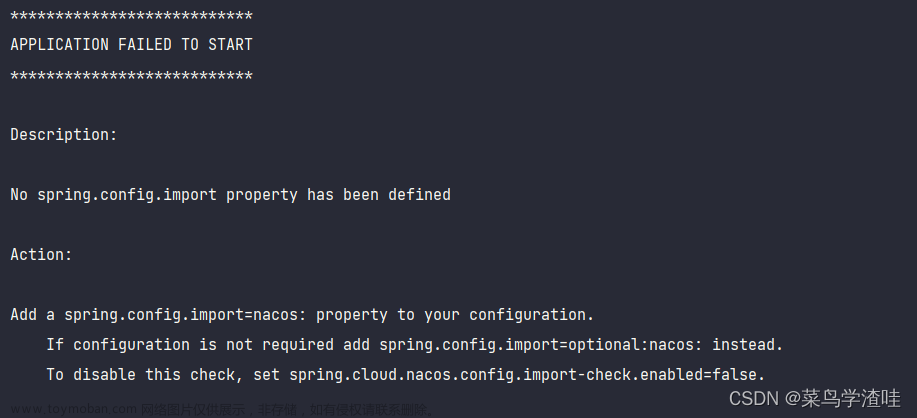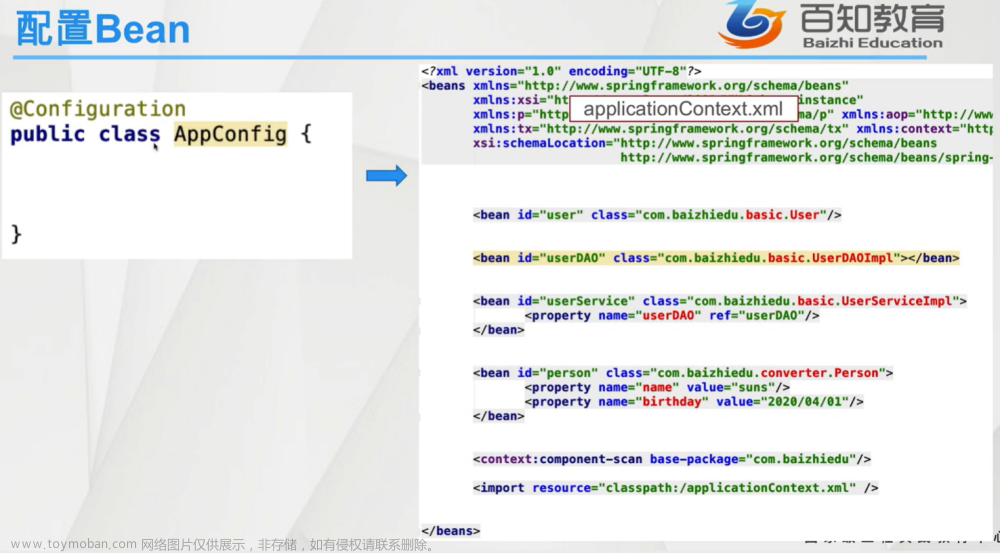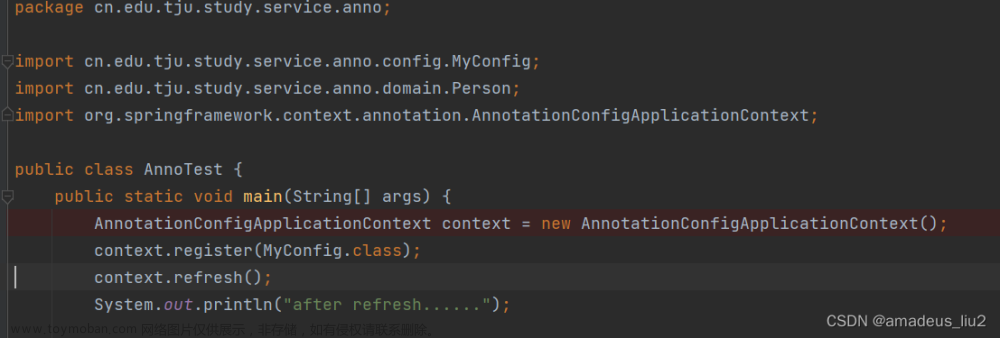@Configuration 全部用法
现在大部分的项目都采用了基于注解的配置,采用了@Configuration 替换 标签的做法。但是最近在翻看Spring 官方文档时,发现@Configuration 声明为基础标签之外,还和大量的其他注解产生化学反应。
@Configuration 基本说明
**定义:指示一个类声明一个或者多个@Bean 声明的方法并且由Spring容器统一管理,以便在运行时为这些bean生成bean的定义和服务请求的类。**例如:
@Configuration
public class AppConfig {
@Bean
public MyBean myBean(){
return new MyBean();
}
}
上述AppConfig 加入@Configuration 注解,表明这就是一个配置类。有一个myBean()的方法,返回一个MyBean()的实例,并用@Bean 进行注释,表明这个方法是需要被Spring进行管理的bean。@Bean 如果不指定名称的话,默认使用myBean名称,也就是小写的名称。
通过注解启动:
通过启动一个AnnotationConfigApplicationContext 来引导这个@Configuration 注解的类,比如:
AnnotationConfigApplicationContext ctx = new AnnotationConfigApplicationContext();
ctx.register(AppConfig.class);
ctx.refresh();
在web项目中,也可以使用AnnotationContextWebApplicationContext 或者其他变体来启动。
新建一个SpringBoot项目(别问我为什么,因为这样创建项目比较快)。
- pom.xml 文件如下:
<?xml version="1.0" encoding="UTF-8"?>
<project xmlns="http://maven.apache.org/POM/4.0.0" xmlns:xsi="http://www.w3.org/2001/XMLSchema-instance"
xsi:schemaLocation="http://maven.apache.org/POM/4.0.0 http://maven.apache.org/xsd/maven-4.0.0.xsd">
<modelVersion>4.0.0</modelVersion>
<parent>
<groupId>org.springframework.boot</groupId>
<artifactId>spring-boot-starter-parent</artifactId>
<version>2.1.5.RELEASE</version>
<relativePath/> <!-- lookup parent from repository -->
</parent>
<groupId>com.spring.configuration</groupId>
<artifactId>spring-configuration</artifactId>
<version>0.0.1-SNAPSHOT</version>
<name>spring-configuration</name>
<description>Demo project for Spring Boot</description>
<properties>
<java.version>1.8</java.version>
</properties>
<dependencies>
<dependency>
<groupId>org.springframework.boot</groupId>
<artifactId>spring-boot-starter-test</artifactId>
<scope>test</scope>
</dependency>
<dependency>
<groupId>org.springframework</groupId>
<artifactId>spring-context</artifactId>
<version>5.0.6.RELEASE</version>
</dependency>
</dependencies>
<build>
<plugins>
<plugin>
<groupId>org.springframework.boot</groupId>
<artifactId>spring-boot-maven-plugin</artifactId>
</plugin>
</plugins>
</build>
</project>
- 在config 包下新建一个MyConfiguration环境配置,和上面的示例代码相似,完整的代码如下:
@Configuration
public class MyConfiguration {
@Bean
public MyBean myBean(){
System.out.println("myBean Initialized");
return new MyBean();
}
}
说明MyConfiguration 是一个配置类,能够在此类下面声明管理多个Bean,我们声明了一个
MyBean的bean,希望它被容器加载和管理。
- 在pojo包下新建一个MyBean的类,具体代码如下
public class MyBean {
public MyBean(){
System.out.println("generate MyBean Instance");
}
public void init(){
System.out.println("MyBean Resources Initialized");
}
}
- 新建一个SpringConfigurationApplication类,用来测试MyConfiguration类,具体代码如下:
public class SpringConfigurationApplication {
public static void main(String[] args) {
// AnnotationConfigApplicationContext context = = new AnnotationConfigApplicationContext(MyConfiguration.class)
// 因为我们加载的@Configuration 是基于注解形式的,所以需要创建AnnotationConfigApplicationContext
AnnotationConfigApplicationContext context = new AnnotationConfigApplicationContext();
// 注册MyConfiguration 类并刷新bean 容器。
context.register(MyConfiguration.class);
context.refresh();
}
}
输出:
myBean Initialized
generate MyBean Instance
从输出的结果可以看到,默认名称为myBean 的bean随着容器的加载而加载,因为myBean方法返回一个myBean的构造方法,所以myBean被初始化了。
通过XML 的方式来启动
- 可以通过使用XML方式定义的
<context:annotation-config />开启基于注解的启动,然后再定义一个MyConfiguration的bean,在/resources 目录下新建 application-context.xml 代码如下:
<?xml version="1.0" encoding="UTF-8"?>
<beans xmlns="http://www.springframework.org/schema/beans" xmlns:xsi="http://www.w3.org/2001/XMLSchema-instance" xmlns:context="http://www.springframework.org/schema/context"
xmlns:util="http://www.springframework.org/schema/util"
xsi:schemaLocation="
http://www.springframework.org/schema/beans http://www.springframework.org/schema/beans/spring-beans-4.2.xsd
http://www.springframework.org/schema/util http://www.springframework.org/schema/util/spring-util-4.2.xsd
http://www.springframework.org/schema/context http://www.springframework.org/schema/context/spring-context-4.2.xsd"
>
<!-- 相当于基于注解的启动类 AnnotationConfigApplicationContext-->
<context:annotation-config />
<bean class="com.spring.configuration.config.MyConfiguration"/>
</beans>
- 需要引入applicationContext.xml ,在SpringConfigurationApplication 需要进行引入,修改后的SpringConfigurationApplication如下:
public class SpringConfigurationApplication {
public static void main(String[] args) {
ApplicationContext context =
new ClassPathXmlApplicationContext("applicationContext.xml");
}
}
输出:
myBean Initialized
generate MyBean Instance
基于ComponentScan() 来获取Bean的定义
@Configuration 使用@Component 进行原注解,因此@Configuration 类也可以被组件扫描到(特别是使用XML context:component-scan 元素)。
在这里认识几个注解: @Controller, @Service, @Repository, @Component
-
@Controller: 表明一个注解的类是一个"Controller",也就是控制器,可以把它理解为MVC 模式的Controller 这个角色。这个注解是一个特殊的@Component,允许实现类通过类路径的扫描扫描到。它通常与@RequestMapping 注解一起使用。 -
@Service: 表明这个带注解的类是一个"Service",也就是服务层,可以把它理解为MVC 模式中的Service层这个角色,这个注解也是一个特殊的@Component,允许实现类通过类路径的扫描扫描到 -
@Repository: 表明这个注解的类是一个"Repository",团队实现了JavaEE 模式中像是作为"Data Access Object" 可能作为DAO来使用,当与 PersistenceExceptionTranslationPostProcessor 结合使用时,这样注释的类有资格获得Spring转换的目的。这个注解也是@Component 的一个特殊实现,允许实现类能够被自动扫描到 -
@Component: 表明这个注释的类是一个组件,当使用基于注释的配置和类路径扫描时,这些类被视为自动检测的候选者。
也就是说,上面四个注解标记的类都能够通过@ComponentScan 扫描到,上面四个注解最大的区别就是使用的场景和语义不一样,比如你定义一个Service类想要被Spring进行管理,你应该把它定义为@Service 而不是@Controller因为我们从语义上讲,@Service更像是一个服务的类,而不是一个控制器的类,@Component通常被称作组件,它可以标注任何你没有严格予以说明的类,比如说是一个配置类,它不属于MVC模式的任何一层,这个时候你更习惯于把它定义为 @Component。@Controller,@Service,@Repository 的注解上都有@Component,所以这三个注解都可以用@Component进行替换。
来看一下代码进行理解:
- 定义五个类,类上分别用@Controller, @Service, @Repository, @Component, @Configuration 进行标注,分别如下
@Component
public class UserBean {}
@Configuration
public class UserConfiguration {}
@Controller
public class UserController {}
@Repository
public class UserDao {}
@Service
public class UserService {}
- 在
MyConfiguration上加上@ComponentScan 注解,扫描上面5个类所在的包位置。代码如下:
@Configuration
@ComponentScan(basePackages = "com.spring.configuration.pojo")
public class MyConfiguration {
@Bean
public MyBean myBean(){
System.out.println("myBean Initialized");
return new MyBean();
}
}
- 修改 SpringConfigurationApplication 中的代码,如下:
public class SpringConfigurationApplication {
public static void main(String[] args) {
// AnnotationConfigApplicationContext context = = new AnnotationConfigApplicationContext(MyConfiguration.class)
// ApplicationContext context = new ClassPathXmlApplicationContext("applicationContext.xml");
AnnotationConfigApplicationContext context = new AnnotationConfigApplicationContext();
context.register(MyConfiguration.class);
context.refresh();
// 获取启动过程中的bean 定义的名称
for(String str : context.getBeanDefinitionNames()){
System.out.println("str = " + str);
}
context.close();
}
}
输出:
myBean Initialized
generate MyBean Instance
str = org.springframework.context.annotation.internalConfigurationAnnotationProcessor
str = org.springframework.context.annotation.internalAutowiredAnnotationProcessor
str = org.springframework.context.annotation.internalRequiredAnnotationProcessor
str = org.springframework.context.annotation.internalCommonAnnotationProcessor
str = org.springframework.context.event.internalEventListenerProcessor
str = org.springframework.context.event.internalEventListenerFactory
str = myConfiguration
str = userBean
str = userConfiguration
str = userController
str = userDao
str = userService
str = myBean
由输出可以清楚的看到,上述定义的五个类成功被@ComponentScan 扫描到,并在程序启动的时候进行加载。
@Configuration 和 Environment
@Configuration 通常和Environment 一起使用,通过@Environment 解析的属性驻留在一个或多个"属性源"对象中,@Configuration类可以使用@PropertySource,像Environment 对象提供属性源
- 为了便于测试,我们引入junit4和spring-test 的依赖,完整的配置文件如下
<?xml version="1.0" encoding="UTF-8"?>
<project xmlns="http://maven.apache.org/POM/4.0.0" xmlns:xsi="http://www.w3.org/2001/XMLSchema-instance"
xsi:schemaLocation="http://maven.apache.org/POM/4.0.0 http://maven.apache.org/xsd/maven-4.0.0.xsd">
<modelVersion>4.0.0</modelVersion>
<parent>
<groupId>org.springframework.boot</groupId>
<artifactId>spring-boot-starter-parent</artifactId>
<version>2.1.5.RELEASE</version>
<relativePath/> <!-- lookup parent from repository -->
</parent>
<groupId>com.spring.configuration</groupId>
<artifactId>spring-configuration</artifactId>
<version>0.0.1-SNAPSHOT</version>
<name>spring-configuration</name>
<description>Demo project for Spring Boot</description>
<properties>
<java.version>1.8</java.version>
<spring.version>5.0.6.RELEASE</spring.version>
<spring.test.version>4.3.13.RELEASE</spring.test.version>
<junit.version>4.12</junit.version>
</properties>
<dependencies>
<dependency>
<groupId>org.springframework.boot</groupId>
<artifactId>spring-boot-starter-test</artifactId>
<scope>test</scope>
</dependency>
<dependency>
<groupId>org.springframework</groupId>
<artifactId>spring-context</artifactId>
<version>${spring.version}</version>
</dependency>
<dependency>
<groupId>org.springframework</groupId>
<artifactId>spring-test</artifactId>
<version>${spring.test.version}</version>
</dependency>
<dependency>
<groupId>junit</groupId>
<artifactId>junit</artifactId>
<version>${junit.version}</version>
</dependency>
</dependencies>
<build>
<plugins>
<plugin>
<groupId>org.springframework.boot</groupId>
<artifactId>spring-boot-maven-plugin</artifactId>
</plugin>
</plugins>
</build>
</project>
- 在config 包下定义一个 EnvironmentConfig 类,注入Environment 属性,完整代码如下:
@RunWith(SpringJUnit4ClassRunner.class)
@ContextConfiguration(classes = EnvironmentConfig.class)
@Configuration
@PropertySource("classpath:beanName.properties")
public class EnvironmentConfig {
@Autowired
Environment env;
@Test
public void testReadProperty(){
// 获取bean.name.controller 的属性
System.out.println(env.getProperty("bean.name.controller"));
// 判断是否包含bean.name.component
System.out.println(env.containsProperty("bean.name.component"));
// 返回与给定键关联的属性值
System.out.println(env.getRequiredProperty("bean.name.service"));
}
}
- 在/resources 目录下新建beanName.properties 文件,如下:
bean.name.configuration=beanNameConfiguration
bean.name.controller=beanNameController
bean.name.service=beanNameService
bean.name.component=beanNameComponent
bean.name.repository=beanNameRepository
启动并进行Junit测试,输出如下:
…………
beanNameController
true
beanNameService
…………
@Autowired 、 @Inject、@Resource 的区别
@Inject: 这是jsr330 的规范,通过AutowiredAnnotationBeanPostProcessor 类实现的依赖注入。位于javax.inject包内,是Java自带的注解。
@Inject
@Named("environment")
Environment env;
不加@Named注解,需要配置与变量名一致即可。
@Autowired: @Autowired 是Spring提供的注解,通过AutowiredAnnotationBeanPostProessor 类实现注入。位于org.springframework.beans.factory.annotation 包内,是Spring 中的注解
@Autowired
Environment env;
默认是通过byType 实现注入
@Resource: @Resource 是jsr250规范的实现,@Resource通过CommonAnnotationBeanPostProcessor 类实现注入。@Resource 一般会指定一个name属性,如下:
@Resource(name = "environment")
Environment env;
默认是通过byName 实现注入
区别:
@Autowired和@Inject基本是一样的,因为两者都是使用AutowiredAnnotationBeanPostProcessor来处理依赖注入。但是@Resource是个例外,它使用的是CommonAnnotationBeanPostProcessor来处理依赖注入。当然,两者都是BeanPostProcessor。
在介绍完上述三者的区别之后,可以对Environment的属性以上述注入方式进行改造
@Value、@PropertySource 和 @Configuration
@Configuration 可以和@Value 和@PropertySource 一起使用读取外部配置文件,具体用法如下:
- 在config 包下新建一个
ReadValueFromPropertySource类,代码如下
@PropertySource("classpath:beanName.properties")
@Configuration
public class ReadValueFromPropertySource {
@Value("bean.name.component")
String beanName;
@Bean("myTestBean")
public MyBean myBean(){
return new MyBean(beanName);
}
}
通过@PropertySource引入的配置文件,使@Value 能够获取到属性值,在给myBean()方法指定了一个名称叫做myTestBean。
- 修改MyBean类,增加一个name属性和一个构造器,再生成其toString() 方法
public class MyBean {
String name;
public MyBean(String name) {
this.name = name;
}
public MyBean(){
System.out.println("generate MyBean Instance");
}
public void init(){
System.out.println("MyBean Resources Initialized");
}
@Override
public String toString() {
return "MyBean{" +
"name='" + name + '\'' +
'}';
}
}
- 在SpringConfigurationApplication中进行测试,如下
public class SpringConfigurationApplication {
public static void main(String[] args) {
// 为了展示配置文件的完整性,之前的代码没有删除。
// AnnotationConfigApplicationContext context = = new AnnotationConfigApplicationContext(MyConfiguration.class)
// ApplicationContext context = new ClassPathXmlApplicationContext("applicationContext.xml");
// AnnotationConfigApplicationContext context = new AnnotationConfigApplicationContext();
// context.register(MyConfiguration.class);
// context.refresh();
//
// // 获取启动过程中的bean 定义的名称
// for(String str : context.getBeanDefinitionNames()){
// System.out.println("str = " + str);
// }
// context.close();
ApplicationContext context =
new AnnotationConfigApplicationContext(ReadValueFromPropertySource.class);
MyBean myBean = (MyBean) context.getBean("myTestBean");
System.out.println("myBean = " + myBean);
}
}
使用Applicatio@InConntext 就能够获取myTestBean 这个bean,再生成myBean的实例。
输出:myBean = MyBean{name=‘bean.name.component’}
@Import 和 @Configuration
@Import的定义(来自于JavaDoc):表明一个或者多个配置类需要导入,提供与Spring XML中相等的功能,允许导入@Configuration 、@ImportSelector、@ImportBeanDefinitionRegistar的实现,以及常规组件类似于AnnotationConfigApplicationContext。可能用于类级别或者是原注解。如果XML或者其他非@Configuration标记的Bean资源需要被导入的话,使用@ImportResource。下面是一个示例代码:
- 在pojo 包下新建两个配置类,分别是CustomerBo, SchedualBo
@Configuration
public class CustomerBo {
public void printMsg(String msg){
System.out.println("CustomerBo : " + msg);
}
@Bean
public CustomerBo testCustomerBo(){
return new CustomerBo();
}
}
@Configuration
public class SchedulerBo {
public void printMsg(String msg){
System.out.println("SchedulerBo : " + msg);
}
@Bean
public SchedulerBo testSchedulerBo(){
return new SchedulerBo();
}
}
- 在config 包下新建一个AppConfig,导入CustomerBo 和 SchedulerBo 。
@Configuration
@Import(value = {CustomerBo.class,SchedulerBo.class})
public class AppConfig {}
- 在config 包下新建一个ImportWithConfiguration ,用于测试@Import 和 @Configuration 的使用
public class ImportWithConfiguration {
public static void main(String[] args) {
ApplicationContext context = new AnnotationConfigApplicationContext(AppConfig.class);
CustomerBo customerBo = (CustomerBo) context.getBean("testCustomerBo");
customerBo.printMsg("System out println('get from customerBo')");
SchedulerBo schedulerBo = (SchedulerBo) context.getBean("testSchedulerBo");
schedulerBo.printMsg("System out println('get from schedulerBo')");
}
}
输出:
CustomerBo : System out println(‘get from customerBo’)
SchedulerBo : System out println(‘get from schedulerBo’)
@Profile
@Profile: 表示当一个或多个@Value 指定的配置文件处于可用状态时,组件符合注册条件,可以进行注册。
三种设置方式:
-
可以通过ConfigurableEnvironment.setActiveProfiles()以编程的方式激活
-
可以通过AbstractEnvironment.ACTIVE_PROFILES_PROPERTY_NAME (spring.profiles.active )属性设置为
JVM属性
-
作为环境变量,或作为web.xml 应用程序的Servlet 上下文参数。也可以通过@ActiveProfiles 注解在集成测试中以声明方式激活配置文件。
作用域
-
作为类级别的注释在任意类或者直接与@Component 进行关联,包括@Configuration 类
-
作为原注解,可以自定义注解
-
作为方法的注解作用在任何方法
注意:
如果一个配置类使用了Profile 标签或者@Profile 作用在任何类中都必须进行启用才会生效,如果@Profile({“p1”,“!p2”}) 标识两个属性,那么p1 是启用状态 而p2 是非启用状态的。
@ImportResource 和 @Configuration
@ImportResource: 这个注解提供了与@Import 功能相似作用,通常与@Configuration 一起使用,通过AnnotationConfigApplicationContext 进行启动,下面以一个示例来看一下具体用法:
- 在config下新建TestService 类,声明一个构造函数,类初始化时调用
public class TestService {
public TestService(){
System.out.println("test @importResource success");
}
}
- 在/resources 目录下新建 importResources.xml ,为了导入TestService
<?xml version="1.0" encoding="UTF-8"?>
<beans xmlns="http://www.springframework.org/schema/beans" xmlns:xsi="http://www.w3.org/2001/XMLSchema-instance" xmlns:context="http://www.springframework.org/schema/context"
xmlns:util="http://www.springframework.org/schema/util"
xsi:schemaLocation="
http://www.springframework.org/schema/beans http://www.springframework.org/schema/beans/spring-beans-4.2.xsd
http://www.springframework.org/schema/util http://www.springframework.org/schema/util/spring-util-4.2.xsd
http://www.springframework.org/schema/context http://www.springframework.org/schema/context/spring-context-4.2.xsd"
>
<bean id = "testService" class="com.spring.configuration.config.TestService" />
</beans>
- 然后在config 下新建一个ImportResourceWithConfiguration, 用于读取配置文件
@Configuration
@ImportResource("classpath:importResources.xml")
public class ImportResourceWithConfiguration {
@Autowired
private TestService service;
public void getImportResource(){
new TestService();
}
public static void main(String[] args) {
AnnotationConfigApplicationContext context =
new AnnotationConfigApplicationContext(ImportResourceWithConfiguration.class);
context.getBean("testService");
}
}
输出:test @importResource success
@Configuration 嵌套
@Configuration注解作用在类上,就和普通类一样能够进行相互嵌套,定义内部类。
// 来自JavaDoc
@Configuration
public class AppConfig{
@Inject
DataSource dataSource;
@Bean
public MyBean myBean(){
return new MyBean(dataSource);
}
@Configuration
static class DataConfig(){
@Bean
DataSource dataSource(){
return new EmbeddedDatabaseBuilder().build()
}
}
}
在上述代码中,只需要在应用程序的上下文中注册 AppConfig 。由于是嵌套的@Configuration 类,DatabaseConfig 将自动注册。当AppConfig 、DatabaseConfig 之间的关系已经隐含清楚时,这就避免了使用@Import 注解的需要。
@Lazy 延迟初始化
@Lazy : 表明一个bean 是否延迟加载,可以作用在方法上,表示这个方法被延迟加载;可以作用在@Component (或者由@Component 作为原注解) 注释的类上,表明这个类中所有的bean 都被延迟加载。如果没有@Lazy注释,或者@Lazy 被设置为false,那么该bean 就会急切渴望被加载;除了上面两种作用域,@Lazy 还可以作用在@Autowired和@Inject注释的属性上,在这种情况下,它将为该字段创建一个惰性代理,作为使用ObjectFactory或Provider的默认方法。下面来演示一下:
- 修改
MyConfiguration类,在该类上添加@Lazy 注解,新增一个IfLazyInit()方法,检验是否被初始化。
@Lazy
@Configuration
@ComponentScan(basePackages = "com.spring.configuration.pojo")
public class MyConfiguration {
@Bean
public MyBean myBean(){
System.out.println("myBean Initialized");
return new MyBean();
}
@Bean
public MyBean IfLazyInit(){
System.out.println("initialized");
return new MyBean();
}
}
- 修改SpringConfigurationApplication 启动类,放开之前MyConfiguration 的启动类
public class SpringConfigurationApplication {
public static void main(String[] args) {
AnnotationConfigApplicationContext context = new AnnotationConfigApplicationContext(MyConfiguration.class);
// ApplicationContext context = new ClassPathXmlApplicationContext("applicationContext.xml");
// AnnotationConfigApplicationContext context = new AnnotationConfigApplicationContext();
// context.register(MyConfiguration.class);
// context.refresh();
//
// // 获取启动过程中的bean 定义的名称
for(String str : context.getBeanDefinitionNames()){
System.out.println("str = " + str);
}
// context.close();
// ApplicationContext context =
// new AnnotationConfigApplicationContext(ReadValueFromPropertySource.class);
// MyBean myBean = (MyBean) context.getBean("myTestBean");
// System.out.println("myBean = " + myBean);
}
}
输出你会发现没有关于bean的定义信息,但是当吧@Lazy 注释拿掉,你会发现输出了关于bean的初始化信息:
myBean Initialized
generate MyBean Instance
initialized
generate MyBean Instance
@RunWith 和 @ContextConfiguration
Junit4 测试类,用于注解在类上表示通过Junit4 进行测试,可以省略编写启动类代码,是ApplicationContext 等启动类的替换。一般用@RunWith 和 @Configuration 进行单元测试,这是软件开发过程中非常必要而且具有专业性的一部分,上面EnvironmentConfig 类证实了这一点:文章来源:https://www.toymoban.com/news/detail-763434.html
@RunWith(SpringJUnit4ClassRunner.class)
@ContextConfiguration(classes = EnvironmentConfig.class)
@Configuration
@PropertySource("classpath:beanName.properties")
public class EnvironmentConfig {
// @Autowired
// Environment env;
@Inject
Environment env;
@Test
public void testReadProperty(){
// 获取bean.name.controller 的属性
System.out.println(env.getProperty("bean.name.controller"));
// 判断是否包含bean.name.component
System.out.println(env.containsProperty("bean.name.component"));
// 返回与给定键关联的属性值
System.out.println(env.getRequiredProperty("bean.name.service"));
}
}
@Enable 启动Spring内置功能
详情查阅@EnableAsync,@EnableScheduling,@EnableTransactionManagement,@EnableAspectJAutoProxy,@EnableWebMvc官方文档文章来源地址https://www.toymoban.com/news/detail-763434.html
@Configuration 使用约束
- 必须以类的方式提供(即不是从工厂方法返回的实例)
- @Configuration 注解的类必须是非final的
- 配置类必须是非本地的(即可能不在方法中声明),native 标注的方法
- 任何嵌套的@Configuration 都必须是static 的。
- @Bean 方法可能不会反过来创建更多配置类
到了这里,关于Springboot之 @Configuration 全部用法的文章就介绍完了。如果您还想了解更多内容,请在右上角搜索TOY模板网以前的文章或继续浏览下面的相关文章,希望大家以后多多支持TOY模板网!







